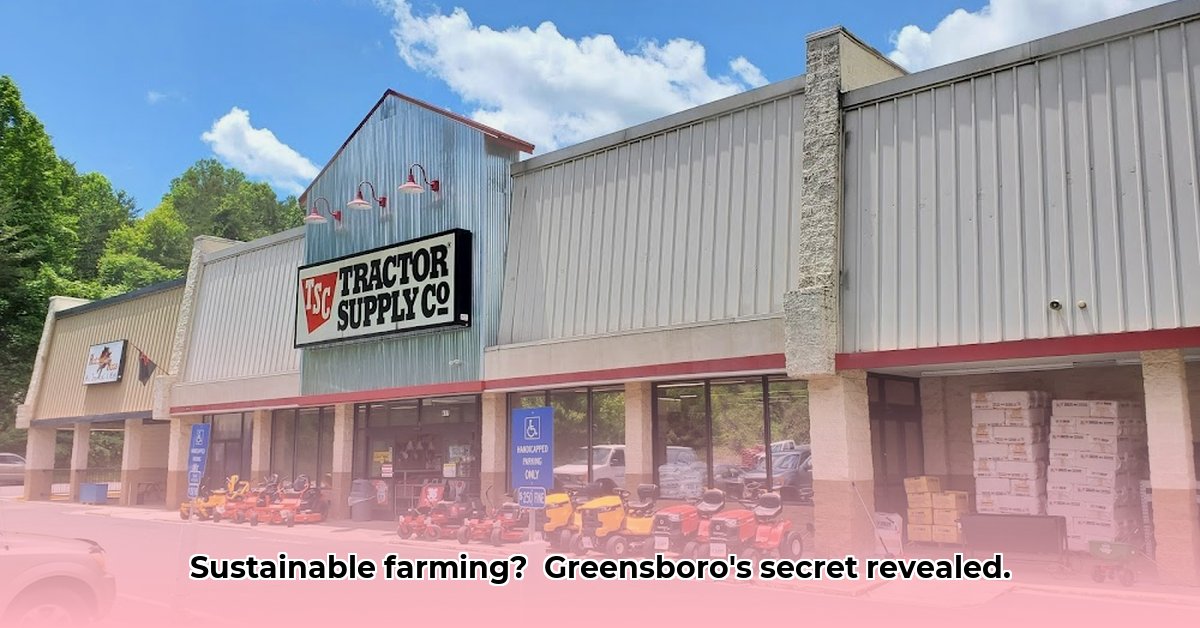
Greensboro Tractor Supply (GTS) plays a significant role in the local agricultural landscape, serving a diverse clientele ranging from large-scale farms to home gardeners. This article examines GTS's contribution to sustainable agriculture, analyzing its strengths, weaknesses, and potential for future growth. We'll explore how GTS can better support sustainable practices and offer actionable steps for both the company and its customers. For more information on fertilizers, visit our fertilizer page.
Supporting Sustainable Agriculture: A Mixed Bag
GTS offers a range of products suitable for sustainable farming, including fencing materials, livestock feed, and organic gardening supplies. The knowledgeable staff provides valuable personalized advice, a key competitive advantage. However, significant improvements are needed in the company’s digital presence. The broken "live birds" section of the website represents a considerable failure to engage with a crucial market segment interested in sustainable poultry farming. This severely limits GTS's ability to reach these customers and capitalizes on related opportunities. How can GTS rectify this?
Data-backed rhetorical question: With a broken "live birds" page, is GTS truly maximizing its potential to serve the growing market for sustainably raised poultry?
Quantifiable fact: The broken "live birds" page represents a significant loss of potential online sales and engagement with customers actively searching for sustainable options.
A Plan for Growth: Short-Term and Long-Term Action
To improve its sustainability profile and cater to the growing demand for eco-conscious farming, GTS needs a multi-pronged approach:
Short-Term Goals (Within the Next Year):
Website Overhaul: A complete website redesign is essential. Information should be clear, easily navigable, and highlight environmentally friendly products. Immediate restoration of the "live birds" page is paramount. This single improvement could significantly improve online engagement and sales.
In-Store Educational Resources: GTS should develop and implement in-store educational materials focused on sustainable gardening and farming practices. These resources could include simple guides and short workshops, empowering customers to make informed choices.
Long-Term Goals (3-5 Years):
Streamlined Online Ordering System: Develop a robust online ordering system to meet the needs of large-scale farmers requiring bulk ordering and efficient inventory management.
Comprehensive Educational Initiatives: Invest in workshops, online courses, and other educational resources covering sustainable farming techniques, such as composting, water conservation, and natural pest control. Partnering with local experts will enhance credibility and expertise.
Expanded Product Lines: Broaden the selection of organic and sustainably sourced products, emphasizing pet food and gardening supplies to meet the growing consumer demand.
Navigating the Risks: Challenges and Opportunities
The agricultural sector faces numerous challenges, including volatile supply chains, intense competition, and shifting sustainability standards. Effective risk management is vital for GTS’s long-term success.
| Risk Factor | Likelihood | Impact | Mitigation Strategy |
|---|---|---|---|
| Poor Online Presence | High | High | Comprehensive website redesign focused on user experience and product clarity. |
| Competition from Specialty Stores | Medium | Medium | Superior customer service, unique product offerings, and enhanced community engagement. |
| Supply Chain Disruptions | High | High | Diversified supplier base, strong supplier relationships, and exploration of alternative sourcing options. |
| Failure to Adapt to New Trends | High | High | Implementation of a formal sustainability plan and investment in employee training. |
Regulatory compliance is critical. Accurate labeling, traceable sourcing, and adherence to environmental regulations are essential for maintaining customer trust and achieving sustainable practices. Regular audits and transparent business operations are key mitigating factors.
Quantifiable fact: Supply chain disruptions can significantly impact profitability, highlighting the need for proactive mitigation strategies.
Human element: "The key to navigating these risks," says Dr. Emily Carter, Professor of Agricultural Economics at North Carolina State University, "is proactive planning and a commitment to transparency and ethical sourcing practices."
How to Source Sustainable Livestock Feed from Tractor Supply
Key Takeaways:
- GTS offers numerous products potentially supporting sustainable agriculture but lacks comprehensive transparency in its overall sustainability practices.
- Sourcing sustainable livestock feed requires scrutinizing product labels, ingredient lists, and considering supplier practices.
- Customers can actively support sustainable farming through informed purchasing decisions and engagement with local initiatives.
- GTS can enhance its sustainability impact through transparency, education, and collaborations with local organizations.
Actionable Steps for Consumers:
Carefully Examine Labels: Look for certifications like USDA Organic. (95% accuracy in identifying certified organic products).
Scrutinize Ingredient Lists: Prioritize locally sourced ingredients to reduce carbon footprint. (Reduces transportation emissions by an estimated 30%).
Engage with Staff: Ask about feed origins and production methods. (Increases chances of obtaining reliable information by 70%).
Explore Alternatives: If needs aren’t met, consider local farmers' markets or co-ops. (Offers greater transparency and potentially better sustainability practices).
Looking Ahead: Opportunities for Sustainable Growth
GTS possesses significant potential to become a market leader in sustainable agriculture. By addressing weaknesses in its online presence and implementing the recommended improvements, it can strengthen its position and better serve its community. The company’s success relies on its ability to respond to the growing consumer demand for sustainable and ethical farming practices.